"Lioness", "Lion" and "Holy Just"
The defeat of the German-Italian troops in North Africa in the spring of 1943, led to the fact that the Italian army was without armored formations - the divisions of Ariete and Chentauro were defeated. Already in May, 1943, in the vicinity of Rome, began the restoration of tank forces. One division (135-I TD "Ariete II") was formed as part of the Royal Army, the other compound, according to the plan of Mussolini, was to become an analogue of the German SS divisions. It was formed from the personnel of the Volunteer Militia of National Security (Milizia Volontaria per la Sicurezza Nazionale - MVSN) or the “Black Shirts”, or rather the “M” battalions, which were the elite of the “black-shirts”. The unit, called the 1 Tank Division of the Black Shirts "M", was created under the leadership of German instructors (from both the SS and the Wehrmacht) and was to receive German weapons. However, after the removal of Mussolini from power, the Germans stopped supplying equipment, and on August 15 1943, the division was subordinated to the command of the Royal Army - it became the 136 TD Chentauro II
In early September 1943, both TDs became part of the Tank-Motorized Corps under the command of General Giacomo Carboni. By this time, the 135 is located in the area of the capital. . 48-I TD, in addition to the 15 Italian tanks M 42 / 75, had 18 German cars: a dozen tanks Pz.Kpfw. IV Ausf. H, Pz.Kpfw. III Ausf. M and assault guns StuG III Ausf. G. 42 – 75 September, parts of the Carboni corps tried to resist the German forces in the area of Rome, but were defeated. Both divisions ceased to exist, and the Germans quickly took over their equipment and weapons. Even obsolete tanks could be used in the Wehrmacht, SS and police, for example, training units or occupying forces in the troubled Balkans.
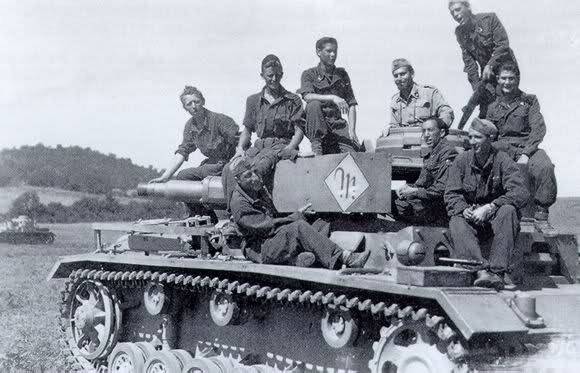
The plan to create the armed forces of the Italian Social Republic (ISR), approved by Hitler in October 1943, provided for the formation of four infantry divisions, but the Germans did not authorize the formation of tank units. Therefore, the command of the ISR army had to resort to improvisation.
"Leonessa"
Many officers and soldiers of the former 136-th TD came from the "black-shirts", remained loyal to Mussolini and sought to continue the struggle on the side of Nazi Germany. It was these military personnel, many of whom had experience of fighting in East Africa (1935 – 1939 years), Greece (1940 – 1941 years) and on the Eastern Front (1942 – 1943 years), which was the backbone of the first tank part of the JSR. The date of its foundation is considered to be 21 September 1943, and this was made possible thanks to the initiative from below. Several dozens of soldiers and officers who languished from idleness in the Mussolini barracks in Rome declared themselves the 4 tank regiment and threw a cry through the Roman radio — everyone who wanted to join them. Soon, part changed its name, becoming a battalion "Leonessa" (it. - "Lioness").
Initially, the battalion was headed by Lieutenant Colonel Fernardino Tezi, but on October 15 1943, he was assigned to the Arms Department of the IMR Ministry of Economics. Tesi was replaced by Major Priamo Switch, who was promoted to lieutenant colonel. The Leonessa battalion was not formed as part of the ISR armed forces, but in the National Republican Guard (Guardia Nazionale Repubblicana - GNR). This formation was analogous to MVSN (disbanded after Mussolini’s dismissal at the end of July 1943), that is, the “Black Shirts”, but unlike her, it was not the Party that was subordinate, but the state.
The main problem that the Leonessa command had to face was the almost complete absence of armored vehicles. The GNR leadership in October 1943 even considered the possibility of reorganizing the battalion into an infantry. The commander of the Leonessa organized several small groups that traveled throughout Northern Italy in search of tanks and armored vehicles. They visited warehouses in Bologna, Vercella, Verona, Siena and other cities - the main problem was to obtain the consent of the Germans to transfer at least some technology. All that I managed to get was brought to Montichiari - this town near Brescia became the site of the battalion's deployment. Here, under the leadership of Lieutenant Giuseppe Soncini organized a repair shop. The efforts of the military yielded their fruits: at the beginning of 1944, Leonessa had 35 medium tanks M 13 / 40, M 14 / 41 and M 15 / 42, five light L 6 / 40, one fighter of the Semovente 47 / 32NUMX / 16 / 33 / 35 / 18 / 41 / 43 75, and one tank destroyer of Semovente 75 / 27N / 37 / XNUMX, one fighter of the Semovente XNUMX / XNUMXNUMX / XNUMX / XNUMX / XNUMX / XNUMX / XNUMX XNUMX / XNUMX M, and one tank destroyer of Semovente XNUMX / XNUMXX / XNUMX / XNUMX / XNUMX / XNUMX. XNUMX and CV XNUMX, XNUMX armored vehicles AB XNUMX and AB XNUMX and one Lynche armored vehicle. There were also a few dozen cars of various brands and even an own artillery battery with four XNUMX-mm XNUMX / XNUMX cannons and eight SPA XNUMX artillery tractors.
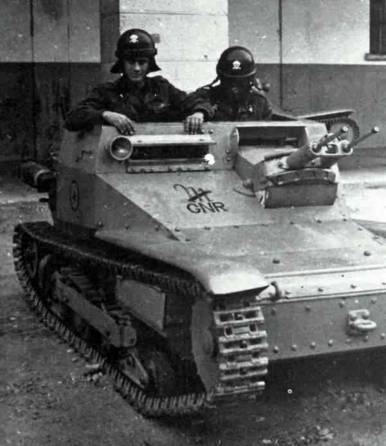
1 February The 1944 Battalion "Leonessa" with all the equipment was marched through the streets of Brescia. GNR Commander Renato Ricci attended the event, praising the efforts of the officers and soldiers of the battalion to equip the units with equipment. On February 9, the Leessess personnel were sworn in. Everyone was waiting for the battalion to be sent to the front, but the GNR command judged in its own way, and the 1 of March was sent to Leonessa to Turin. The tanks and armored vehicles of the battalion were to support counterguerrilla operations in Piedmont.
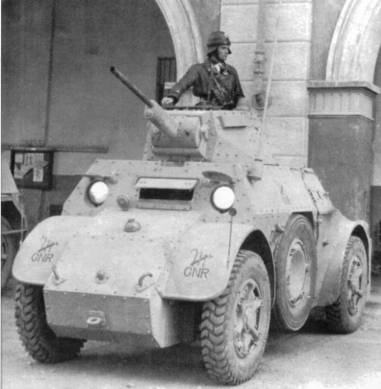
From 21 in March 1944, the X XUMUMX armored cars and 41 / 13 tanks and 40 / 14 tanks M of the Leonessa battalion cooperated with the Italian SS battalion “Dębitsa” (named for the Polish city of the same name, where he received training), who fought with the Gharbari Balibalbi’s fight against the Gharbybrahs. guerrilla brigade "Pizacane" north of Milan. At first, the tankers advanced very carefully, fearing that the enemy had anti-tank weapons. The threat turned out to be exaggerated, and the Leonessa units began to act more decisively. The most fierce fighting broke out in the vicinity of the town of Pontevecchio: here the battalion lost two armored vehicles (the crew of one died, the other - captured by partisans).
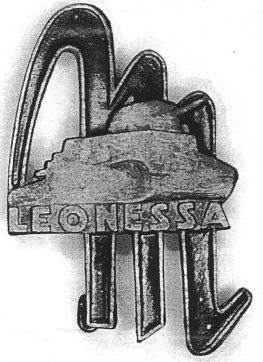
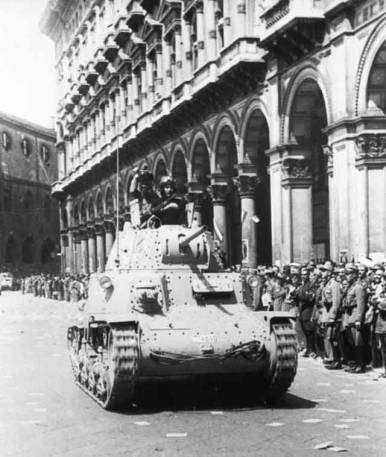
In April-May, the XeNuss units of the Leonessa force operated from a platoon to a company in various areas - in the vicinity of Milan, Leccio, Como, Cassano d'Adda. The strongest detachment fought in Strambino-Romano, on the territory of the "partisan region" - "The liberated zone of Incria". Tankers supported parts of the GNR, the "black brigades", as well as German units. Anti-Guerrilla operations continued in the summer - one of the most interesting episodes took place in July in the city of Piacenza. Here the partisans attempted to attack the local arsenal, but the Leonessa unit managed to repel the attack. After that, the tankers judged that the partisans could repeat the raid, and profoundly profit from the property stored in the arsenal: a couple of dozen machine guns, a large amount of ammunition and fuel. In addition, their “trophy” became the tank 1944 / 14 M in the commander version (without a gun, but with powerful radio equipment).
In April-May, the XeNuss units of the Leonessa force operated from a platoon to a company in various areas - in the vicinity of Milan, Leccio, Como, Cassano d'Adda. The strongest detachment fought in Strambino-Romano, on the territory of the "partisan region" - "The liberated zone of Incria". Tankers supported parts of the GNR, the "black brigades", as well as German units. Anti-Guerrilla operations continued in the summer - one of the most interesting episodes took place in July in the city of Piacenza. Here the partisans attempted to attack the local arsenal, but the Leonessa unit managed to repel the attack. After that, the tankers judged that the partisans could repeat the raid, and profoundly profit from the property stored in the arsenal: a couple of dozen machine guns, a large amount of ammunition and fuel. In addition, their “trophy” became the tank 1944 / 14 M in the commander version (without a gun, but with powerful radio equipment).
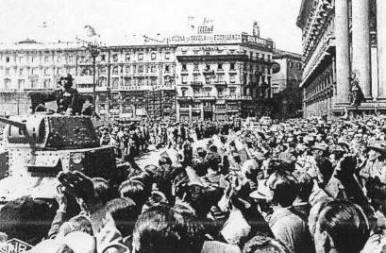
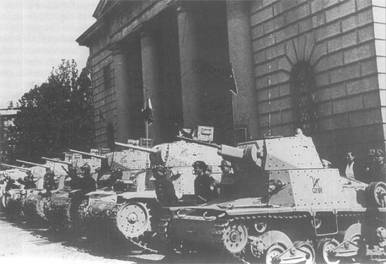
On August 7, 1944, the Leonessa battalion was included in the Air and Antitank Division Etna (Divisione Contraerea e Contracarro Etna). This became a purely nominal act - as before, battalion units were scattered throughout northern Italy, taking an active part in counterguerrilla operations. Not least thanks to the support of tankers in August 1944, the ISR forces managed to clear the Aosta valley from partisans, releasing several garrisons that had been surrounded for a long time. The 2nd company, which had five M 13/40 and M14 / 41 tanks, as well as a dozen AB 41 armored vehicles, participated in the operation in the Ossol Valley in September-October. On November 2, this unit, together with the Venice-Giulia bicycle battalion and the “black brigade” “Cristina,” knocked out partisans from the city of Alba. The 3rd company, formed in the autumn of 1944, operated in the Emilian Apennines, protecting communications between Parma, Piacenza and Trebbia. Finally, the 4th company was entrusted with the task of protecting the oil fields in Montechino. But if tankers could still resist the attacks of partisans, then against enemy raids aviation they were powerless. In the spring of 1945, oil fields were systematically destroyed.
On the night of 19 on 20, April, the last oil transport departed from Montechino, and with it the 4 company, which joined the Leonessa company in Piacenza. Together with the other parts of the GNR, the Italian SS Legion and German units, they fought off partisan attacks until April 3, when advanced units of the American 28 Infantry Division approached the city. The 36 and 3 companies retreated to Turin, joining the rest of the Leonessa units. The retreat continued in the direction of the Aosta Valley. Here in the evening of May 4, the Leonessa battalion surrendered to the Americans along with other Italian units.
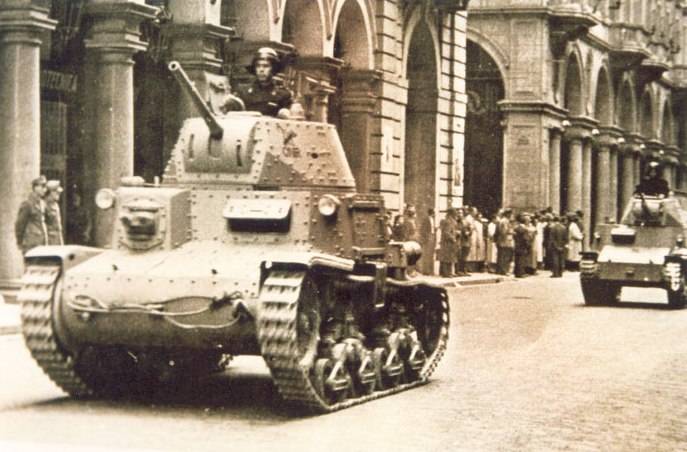
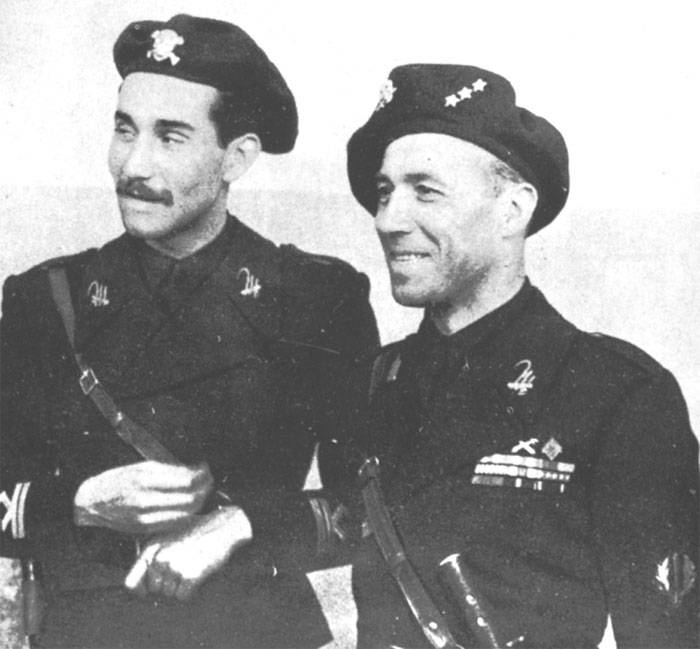
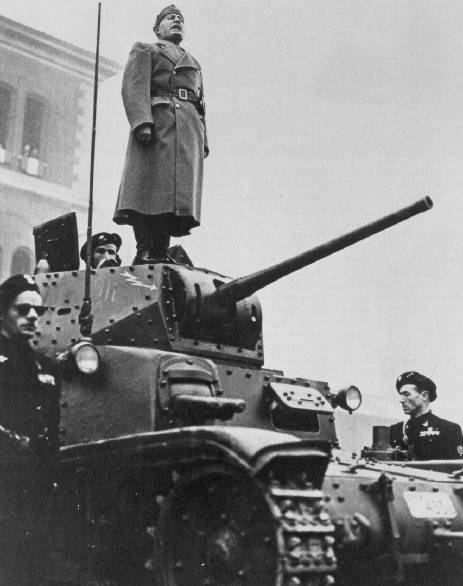
"Leoncello"
The second tank unit in the ISR’s armed forces appeared only a year after the “Leessess”. The battalion, which was named “Leonechello” (it is “lion”), was formed on September 13 on the initiative of Captain Giancarlo Tsukkaro, an experienced cavalierist and veteran of the Eastern Front. After the capitulation of Italy, he served for some time in the Wehrmacht, and then transferred to the army of ISR, where he taught at the cadet school in Modena, and then in Tortona. In the summer of 1944, a rebellion broke out in the town, which was decisively suppressed under the leadership of Zuccaro. After that, the brave captain received a personal order from Mussolini to form a tank battalion of the guard of the Ministry of Armed Forces ISR, located in the town of Polpenacza on Lake Garda.
Organizationally, the battalion consisted of three companies: medium tanks "M" (four tanks M 13 / 40 and three M 15 / 42); “L” light tanks (twelve CV 33 tank shoes); headquarters, which had four armored vehicles AB 40 and AB 41, as well as one self-propelled gun Semovente 105 / 25. In addition, the battalion had a half dozen vehicles of various types and four 20-mm anti-aircraft guns "20 / 77". The number of Leoncello personnel at the end of September 1944 was 122 people (10 officers, 20 sergeants and 92 privates).
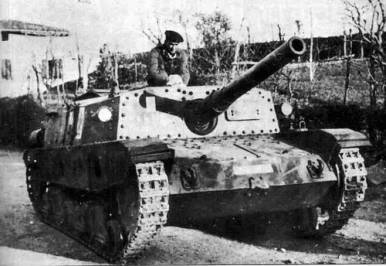
With the formation of the Leoncello battalion, the idea arose of merging it with the Leonessa into a tank regiment, but this was strongly opposed by Captain Zuccaro, who said that he would never put on a black shirt. The battalion continued relatively calm garrison service, engaged in combat training. In his first (and, as it turned out, the last) battle "Leoncello" entered at the very end of the war. By order of the command, the battalion went to the region of Brescia to support the units of the 10 division of the MAS that had fought there. At the approaches to the city, the tankers were surrounded by partisans from the Fiamme Verdi brigade. In the battle, which lasted several hours, the battalion suffered heavy losses - using captured “Panzerfausts”, the partisans hit most of its tanks. Ten Leoncello fighters were killed. 28 – 29 April 1945, his units capitulated: company M on the road to Milan; Company "L" - in Lonigo; headquarters company - in Polpenazza.
"San Giusto"
In addition to Italy itself, a significant number of Italian troops as of September 1943 were deployed in the Balkans. After the capitulation, there was also confusion and vacillation: many officers and soldiers sought to continue the struggle on the side of Germany. One of them was Captain Agostino Tonegutti, who commanded a company of San Giusto light tanks assigned to the Masnerath 153 Infantry Division, which was stationed in the northwestern part of Croatia. After the capitulation of Italy, he headed like-minded people who declared their intention to fight on the side of the Third Reich. The unit, which had several tankettes, became part of the general group of General Gastone Gambar, defending Fiume (now Rijeka) from the Yugoslav partisans, who tried to take advantage of the confusion of the Italian command. Subsequently, the unit, already called the battalion, was transferred to Istria, and in early February, 1944 arrived in the Italian city of Gorizia and became part of the regular army of JRI. The battalion was given the task of supporting the units defending the Adriatic coast.
Armament "San Giusto", as well as other tank units of the ISR, was very unsuited. In February 1944, the battalion had five medium tanks M 13 / 40 and M 14 / 41, 16 tanks X XUMUM and CV 33 tanks, six different AI keyboards, each of which was autologed-by-push-by-computers (one Semovente 35 and X-NUMX / 42 and М75 34 / 41 and X-NUMX systems). and two Semovente L75 18 / 42), as well as four armored cars AB 75. The number of personnel ranged from 18 – 6 people.
The main tasks of the San Giusto battalion were escorting columns between the cities of Trieste, Udine and Gorizia, as well as the struggle against the Italian and Yugoslav partisans operating here. Not always without losses. Thus, on May 31, the unit of the San Giusto battalion, which accompanied the German convoy, was attacked by partisans between the towns of Dobrale and Titina. The attack was able to repel, but the Italians lost the tank M 1944 / 14 and two armored vehicles AB 41. December 41 as a result of a mine blast destroyed another armored car, killing its entire crew (five people). The total irretrievable losses of the San Giusto battalion over the entire period of participation in hostilities were relatively small and amounted to 6 people. The situation with the equipment was much worse - by April 15, only eight tankettes, three medium tanks and two self-propelled guns remained in the battalion. Its existence, "San Giusto" 1945 ceased April 27 of the year, surrendering to the British. According to other data, the surrender took place only on May 1945 (perhaps it is a question of the surrender of various divisions of the battalion).
Other tank units
In addition to the “Leonessa”, “Leoncello” and “San Giusto”, there were several tank units in the armed units of the ISR. In particular, the Anti-Guerrilla Group formed in the summer of 1944 (Raggruppamento Anti Partigiani - RAP) had a tank battalion of a two-month structure. Initially, his armor consisted of seven tankettes, two light tanks L 6 / 40, one medium M 13 / 40, two self-propelled guns Semovente M42 75 / 18 and one armored vehicle AB 41. Since September, 1944, the RAP has acted in Piedmont, fighting against partisans. Tankers participated in this “Italian-Italian” war until 28 on April 1945.
For a while in the 1 Bersalier Division “Italy” there existed a supernumerary assault gun division with nine ACS Semovente 75 / 18. The Apennine rangers group (Raggruppamento Cacciatori degli Appennini) used four Semovente M42 75 / 18 self-propelled guns and six AB 41 armored cars. Several tanks and tank shoes served in a number of units of the ISR army, the National Republican Guard and the Black Brigades.
Summing up our narration, we note several features inherent in the tank units of the ISR. First, all of them, without exception, were improvised formations created outside of any states. The organizational structure of these parts was based on the available technology. Secondly, all the ISR tank units were not designed for use on the front, but to ensure internal security and participation in counterguerrilla operations. It is no coincidence that the largest and most efficient of them - the Leonessa tank battalion - was part of the National Republican Guard, not the army. Thirdly, the system for providing tank units was absent as such: all the concerns regarding the acquisition of equipment and keeping it in combat readiness rested entirely on the shoulders of battalion commanders and companies.
Information